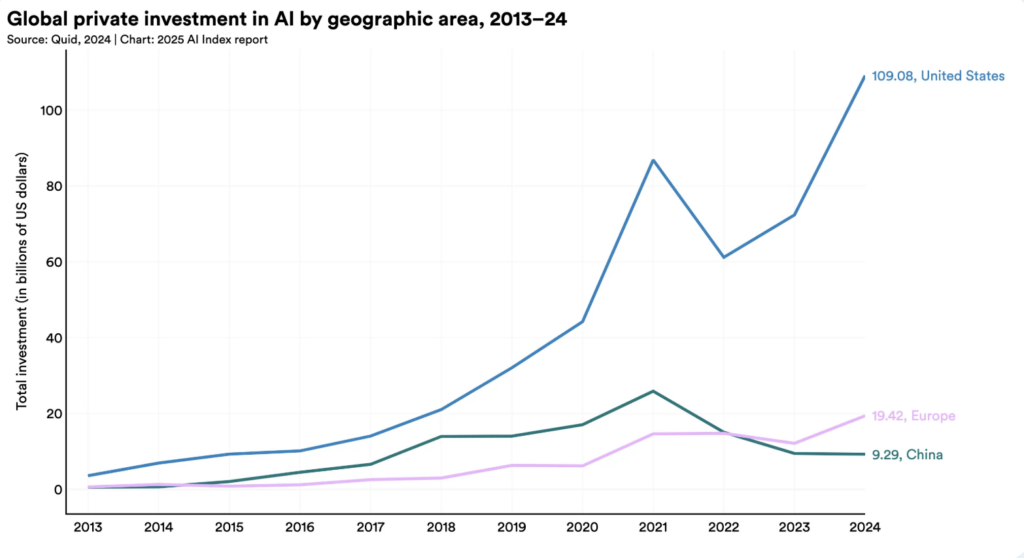The 2025 AI Index Report, recently released by Stanford’s Human-Centered Artificial Intelligence (HAI), offers an insightful overview of the current state and trajectory of artificial intelligence (AI). While the comprehensive report spans an extensive 456 pages, here are the top six observations that stood out:
1. AI Nears Human-Level Performance
AI research accelerated dramatically in 2024, marking substantial improvements in challenging benchmarks. Notably, performance surged across key tests:
- MMMU (multitask language and multimodal understanding): Improved by 18.8 percentage points.
- GPQA (general-purpose question answering): Rose sharply by 48.9 percentage points.
- SWE-bench (real-world coding challenges): Remarkably increased from solving 4.4 percent of problems in 2023 to 71.7 percent in 2024.
This pace of progress has led many AI leaders to believe that artificial general intelligence (AGI) may arrive sooner than expected. Anthropic CEO Dario Amodei recently said that by 2027 we will have AI systems that have:
- The intellectual capabilities matching or exceeding those of Nobel Prize winners across most disciplines—including biology, computer science, mathematics, and engineering;
- The ability to navigate all interfaces available to a human doing digital work today, including the ability to process and generate text, audio, and video, the ability to autonomously control technology instruments like mice and keyboards, and the ability to access and browse the internet;
- The capacity to autonomously reason through complex tasks over extended periods—hours, days, or even weeks; and
- The ability to interface with the physical world, such as robotics.
Whether that timeline proves accurate or overly optimistic, one thing is undeniable: AI capabilities are advancing at an accelerated pace. Now is the time for leaders to begin grappling with the profound questions this trajectory raises—about the future of work, education, health care, and the very structure of society in an age of increasingly intelligent machines.

2. The US Leads on AI Models
The US remains the global leader in developing notable AI models, releasing 40 significant models in 2024—far surpassing China’s 15 and Europe’s mere three.

3. But China Is Catching Up in Quality
While the US maintains its quantitative advantage, China has rapidly narrowed the quality gap, significantly reducing performance disparities with American models across key AI benchmarks between 2023 and 2024. China also remains the global leader in AI-related publications and patents.


4. Rising Performance, Falling Costs
The affordability of high-performing AI models has dramatically increased. The cost to query a model at GPT-3.5’s performance level dropped from $20 per million tokens (November 2022) to merely $0.07 per million tokens (Gemini-1.5-Flash-8B) by October 2024—a 280-fold reduction in just 18 months.

5. The US Dominates Global AI Investment
In 2024, the US continued to dominate global private investment in AI, attracting $109.1 billion—approximately 11.7 times more than China ($9.3 billion), the second-highest country, and 24.1 times more than the United Kingdom ($4.5 billion), the third-highest.


6. Promising Studies Point to a Revolution in Health Care
Healthcare and medical research are seeing immensely promising results from some early research.
A recent Stanford study with the Chan Zuckerberg BioHub demonstrated an innovative virtual AI laboratory where multiple AI-agent scientists collaborate autonomously across different disciplines. Structured similarly to a traditional computational biology lab, the virtual team consisted of a principal investigator, a scientific critic, and three specialists focused on immunology, computational biology, and machine learning.
In one experiment, researchers tasked this AI-driven lab with designing nanobodies capable of binding to SARS-CoV-2. The AI lab successfully generated 92 nanobodies, over 90 percent of which effectively bound to the virus in validation tests. The significance of this study extends beyond the specific results—it showcases how an entirely autonomous, large language model-driven laboratory can independently achieve meaningful scientific breakthroughs.

Another striking finding from HAI’s report was a randomized trial involving 50 US-licensed physicians evaluating GPT-4 assistance for diagnosing complex clinical cases. Physicians supported by GPT-4 had a modest accuracy improvement (76 percent) compared to traditional methods (74 percent). However, GPT-4 alone outperformed both, achieving a remarkable 92 percent accuracy, highlighting the potential for AI to significantly enhance diagnostic capabilities.

Policymakers should take careful note of these developments. The US’s current lead in AI may not remain uncontested, especially with countries like China rapidly advancing. Ensuring that the US maintains its leadership requires proactive, thoughtful policy-making and regulatory frameworks that foster innovation, investment, and responsible AI use. Only through deliberate and informed policy decisions can the US sustain its competitive edge and harness AI’s full potential for economic growth and societal benefit.